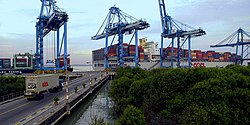Port Klang
|
Port Klang Pelabuhan Klang |
|
|---|---|
| Town | |
 |
|
| Coordinates: 3°0′0″N 101°24′0″E / 3.00000°N 101.40000°E | |
| Country | Malaysia |
| State | Selangor |
| District | Klang |
| Government | |
| • Municipal Council | Klang Municipal Council |
| • Local Authority | Port Klang Authority |
| Area | |
| • Total | 573 km2 (221 sq mi) |
| Time zone | MST (UTC+8) |
| Postcode | 42000 |
| Dialling code | +60 3 |
| Police | Port Klang, Pulau Ketam and Pandamaran |
| Fire | Northport, Port Klang |
| Website | http://www.pka.gov.my |
Port Klang (Chinese: 吧生港口; Jyutping: baa1 saang1 kong2 hau2) is a town and the main gateway by sea into Malaysia. Known during colonial times as Port Swettenham (Chinese: 瑞天咸港口) but renamed Port Klang in July 1972, it is the largest port in the country. It is located about 6 kilometres (3.7 mi) southwest of the town of Klang, and 38 kilometres (24 mi) southwest of Kuala Lumpur.
Located in the District of Klang, it was the 12th busiest container port (2012) in the world. It was also the 17th busiest port in by total cargo tonnage handled in 2012.
Klang was formerly the terminus of the government railway and the port of the State. In 1880, the state capital of Selangor was moved from Klang to the more strategically advantageous Kuala Lumpur. Rapid development at the new administrative centre in the late 1800s attracted businessmen and job seekers alike from Klang. At this time the only methods of transport between Klang and Kuala Lumpur were by horse or buffalo drawn wagons, or boat ride along the Klang River to Damansara. Due to this Frank Swettenham stated to Selangor's British Resident at the time, William Bloomfield Douglas, that the journey to Kuala Lumpur was "rather long and boring". He continued to suggest a train line be built as an alternative route.
In September 1882, Sir Frank Athelstane Swettenham was appointed Selangor’s new Resident. Swettenham initiated a rail link between Klang and Kuala Lumpur to overcome the transport problems particularly of the tin mining interests, who needed to convey the ore to Klang's port, Pelabuhan Batu. Nineteen and a half miles of rail track from Kuala Lumpur to Bukit Kudu was opened in September 1886, and extended 3 miles to Klang in 1890.
...
Wikipedia

